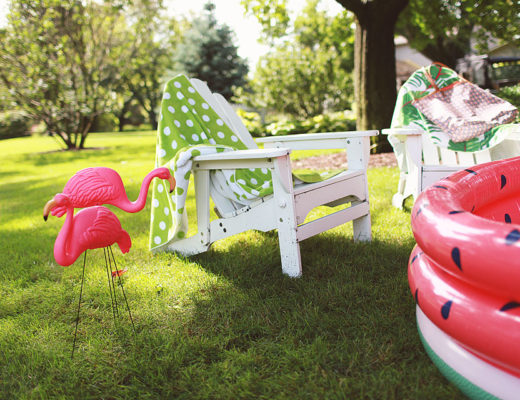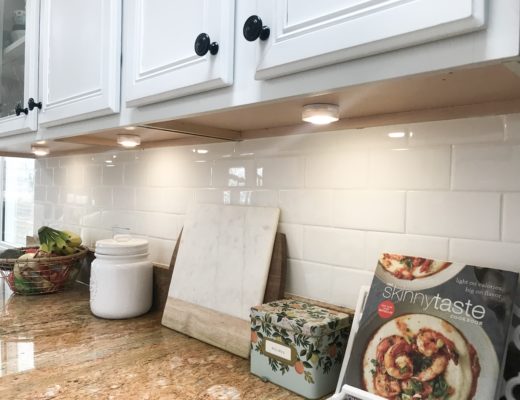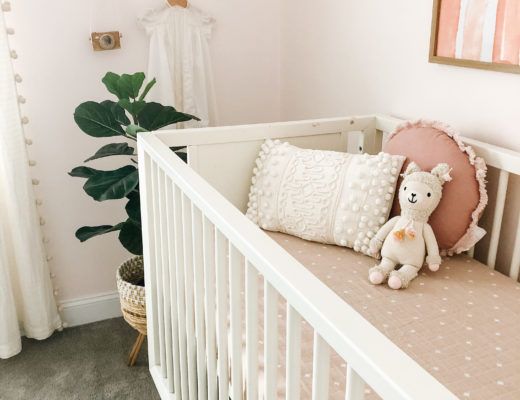If you hate your wire shelving in your kitchen pantry, this post is for you! The photo below is exactly how we found the pantry when we bought the house…one shelf hanging on by a thread (at the bottom) and the rest of the shelves were very beat up. It honestly grossed me out. Maybe it was the mom in me because Andrew did not seem to care. “It’s a pantry, no one sees it.” Umm….I see it every day when I open the door for every single meal?! I want it to be pretty and clean!
When I decided to demolish the existing shelves, I did not have a plan in place. I had thought to myself, “how hard can it be to find shelves to fit?” Oh boy, was I wrong. I looked EVERYWHERE both in-store and online for shelving that would fit this deep, spacious pantry. Seriously, I think I looked every night for a week straight before giving up. Andrew and I decided it was time to consider building something, and it turned out to be the easiest project ever with one caveat, you just have to have the right tools for the job.

DIY Pantry Shelves
Tools
- Drill
- Table Saw or Circular Saw (table saw is preferred but we used a circular saw and it was fine. If you use a circular saw, you’ll also need some sort of sawhorse)
- Trim Nail Gun & Nails
- Stud Finder (optional if you are good at finding studs)
- Level
Materials
- Furring Strips
- Screws
- Drywall Anchors (if you can’t find studs)
- Ruler
- Shelving Wood (we used 3/4″ Birch Plywood)
- Decorative Lattice (to make the front wood look finished – it’s basically a thin trim)
- Wiping stain of your choice
- Paint brush
- Polyurethane (optional but a good idea)
We made two mistakes (bought too thin of board at first and I didn’t like my initial stain color), so I probably spent around $160, but you could definitely do this for right around $120 (depending on number of shelves and the tools you already own)!


Process
- Furring strips are used to support the wood shelves (see above photos), they are essentially your anchors that get placed on each wall. You’ll need to measure your walls and use your saw to cut the furring strips into the lengths you need. Ideally, you’ll paint these whatever color you’d like before installing (mine are white to blend into the wall), but I didn’t do that. Use your level, stud finder, screws and anchors to install once you’ve made the cuts. We used 3 screws on each strip and they are very secure!
- Because we had existing shelves, we used those as a baseline to measure what size plywood we needed to buy (it comes in 2′ x 4′ planks at Home Depot which was perfect for our needs). We re-measured wall to wall before cutting to ensure we got it just right. You’ll need your saw to make the cuts (don’t forget your safety glasses!!).
- We made four shelves in total and set them all on the furring strips to ensure they fit properly. Once we felt good about the shelves, I took them out to stain and finish. I also stained the decorative lattice at this point as well. This is the fun part – you can use any stain you want! My mom has a plethora of stains in her basement, so I got lucky! I chose Old Masters Provincial from her stash (you have to go to a local specialty paint store to find it). Once the shelves and lattice were dry, I put a coat of Polyurethane to protect the wood from getting damaged. It makes the wood a little slicker and easier to clean, you can pick up Poly at Lowes or Home Depot.
- Last step, put the shelves back in and use your nail gun to secure them to the furring strips. Once the shelves are securely in place, measure the front of each shelf to cut your lattice. The lattice gives it that clean, finished look instead of leaving it looking like raw wood. Once your lattice is cut, use your nail gun to secure in place – you’ll never see the holes!
- Enjoy your new pantry!



If you’re looking for more of my home renovation updates, be sure to check out my latest post here.



